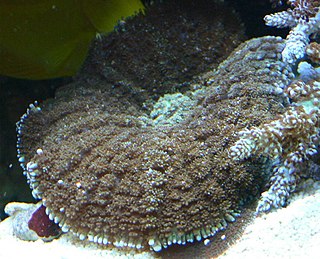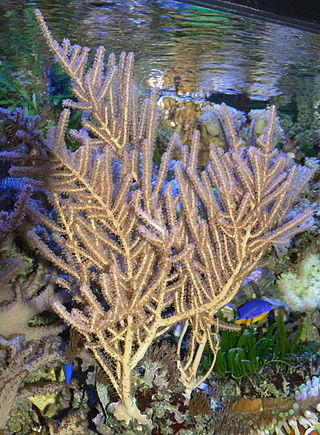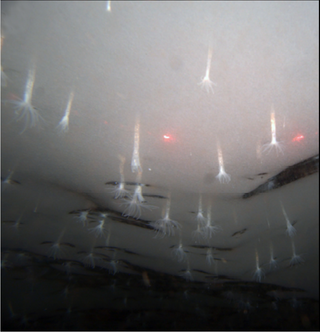
Acropora is a genus of small polyp stony coral in the phylum Cnidaria. Some of its species are known as table coral, elkhorn coral, and staghorn coral. Over 149 species are described. Acropora species are some of the major reef corals responsible for building the immense calcium carbonate substructure that supports the thin living skin of a reef.

Actiniidae is the largest family of sea anemones, to which most common, temperate, shore species belong. Most members of this family do not participate in symbioses with fishes. Three exceptions are the bubble-tip anemone, snakelocks anemone and Urticina piscivora.

Edwardsia is a genus of sea anemones, the type of the family Edwardsiidae. They have eight mesenteries and live in tubes in the sand. The name, in Neo-Latin, commemorates the French zoologist Henri Milne-Edwards.

Stichodactyla is a genus of sea anemones, of the family Stichodactylidae. They are host anemones, which maintain a relationship mutualistic with other animals, in their case with crabs of the genus Mithraculus, shrimp of the genus Periclimenes , and with various species of clownfish, of the genus Amphiprion, establishing a relationship of coexistence. In this way, crabs and fish protect themselves from their predators between the stinging tentacles of the anemone, and the anemone benefits from the cleaning of its oral disc and tentacles as a result of the continuous movements of the animals.

Rhodactis is genus of mushroom corals which are characterized by large individual polyps that are often reminiscent of a mushroom. Rhodactis are related to stony corals but do not produce a stony skeleton.

Corynactis is a genus of colonial anthozoans similar in appearance to sea anemones and in body format to scleractinian stony corals. These animals are cnidarians in the family Corallimorphidae. Large unidentified polyps of this genus feed on the crown-of-thorns seastar Acanthaster planci and may help control the crown-of-thorns population.

Anthothoe is a genus of sea anemones in the family Sagartiidae.

Bunodactis is a genus of sea anemones in the family Actiniidae.

Epiactis is a genus of sea anemones in the family Actiniidae. There are about nineteen recognised species and the type species is Epiactis prolifera.

Actinia is a genus of sea anemones in the family Actiniidae. Actinia display a rare form of heteromorphosis in which a cut inflicted on a specimen can develop into a second mouth.

Holaxonia is a suborder of soft corals, a member of the phylum Cnidaria. Members of this suborder are sometimes known as gorgonians and include the sea blades, the sea fans, the sea rods and the sea whips. These soft corals are colonial, sessile organisms and are generally tree-like in structure. They do not have a hard skeleton composed of calcium carbonate but have a firm but pliable, central axial skeleton composed of a fibrous protein called gorgonin embedded in a tissue matrix, the coenenchyme. In some genera this is permeated with a calcareous substance in the form of fused spicules. Members of this suborder are characterized by having an unspiculated axis and often a soft, chambered central core. The polyps have eight-fold symmetry and in many species, especially in the families Gorgoniidae and Plexauridae, contain symbiotic photosynthetic algae called zooxanthellae. These soft corals are popular in salt water aquaria.

Gorgoniidae is a family of soft corals, a member of the subclass Octocorallia in the phylum Cnidaria. Nearly all the genera and species are native to the east and west coasts of America.

Edwardsiidae is a family of sea anemones. Edwardsiids have long thin bodies and live buried in sediments or in holes or crevices in rock.

Palythoa is a genus of anthozoans in the order Zoantharia.

Merulinidae is a family of reef-building stony corals.
Anthopleura stellula is a species of sea anemone in the family Actiniidae. It was first described in 1834 by Wilhelm Hemprich and Christian Gottfried Ehrenberg as Actinia (Isacmaea) stellula. It is found in the Indian Ocean and the Red Sea, and is unusual among sea anemones in that it can divide itself in two transversely.

Edwardsiella is a genus of sea anemones in the family Edwardsiidae. It is named in honour of Henri Milne-Edwards, an eminent French zoologist.

Heterodactyla is a genus of sea anemones of the family Thalassianthidae. The genus was first described in 1834 by Wilhelm Hemprich and Christian Gottfried Ehrenberg.
Gyrostoma is a genus of cnidarians belonging to the family Actiniidae.
















